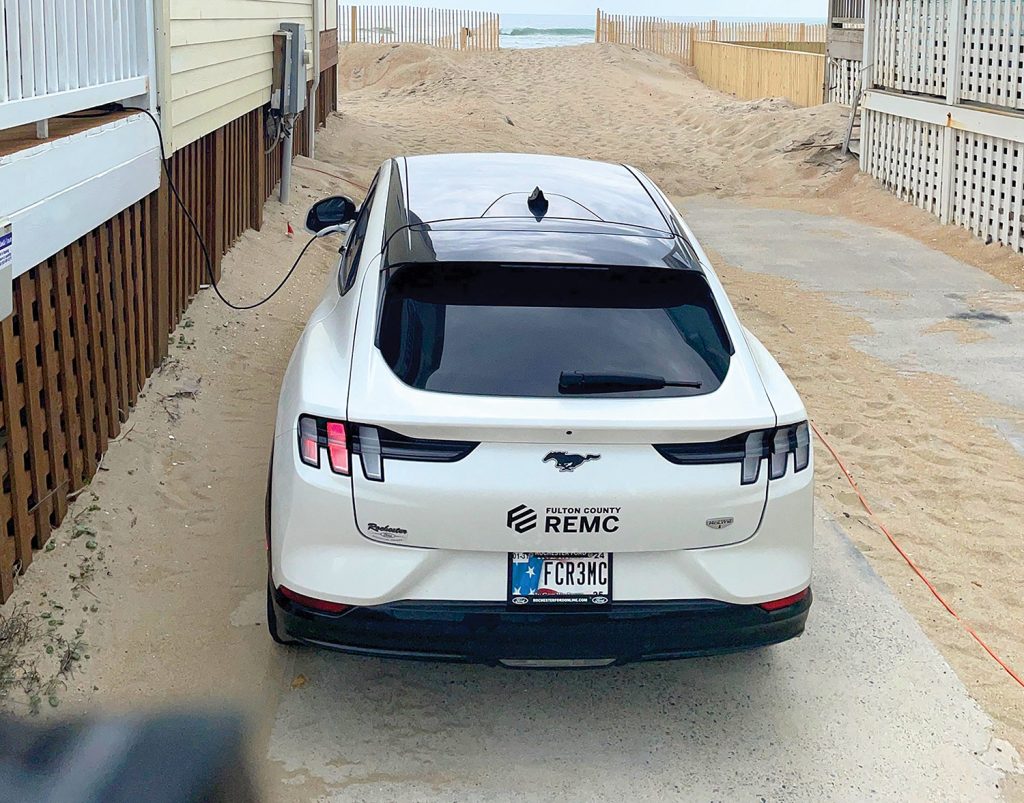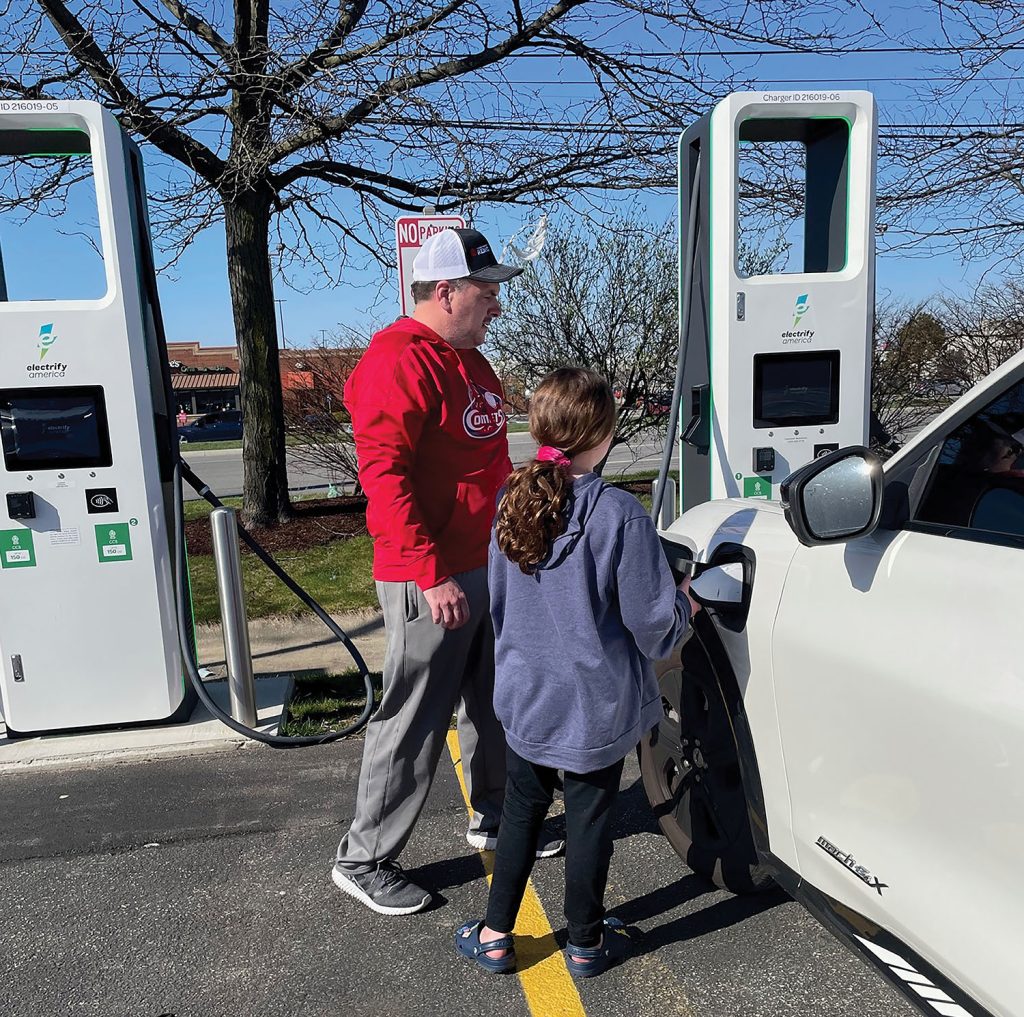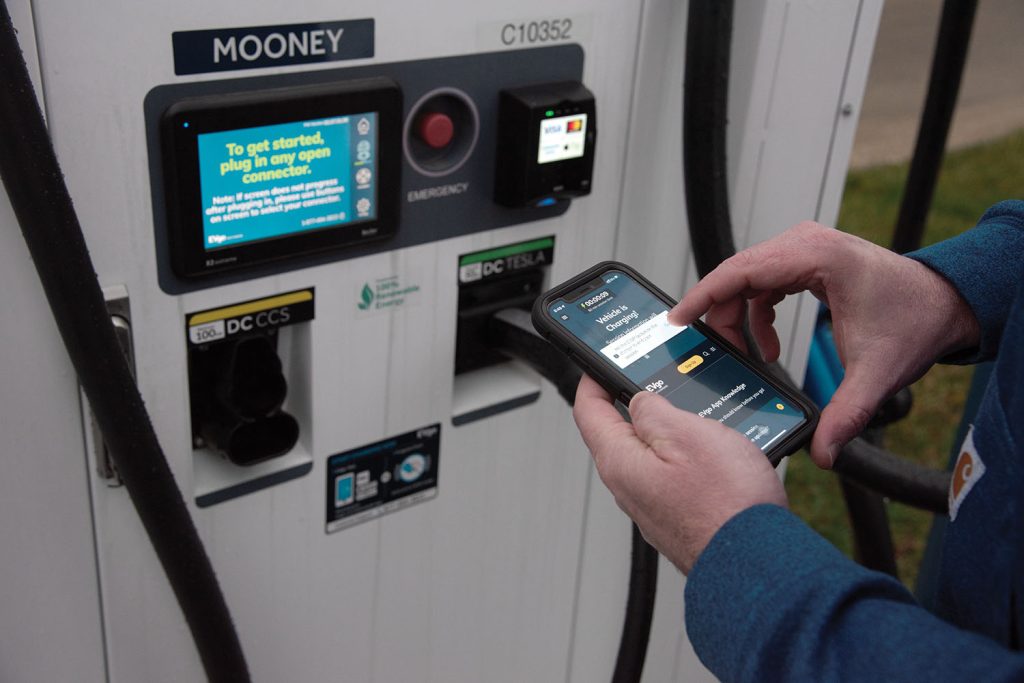
Motorists have long been told we were on a journey to a greener place. Just around the bend was a new world where electric vehicles would easily merge alongside gas-powered vehicles. But for decades, as we rounded the curves, topped hills and traveled long stretches, we passed untapped power lines. And from the back seat of America came the dispirited plea, “Are we there yet?”
At last, after false starts, dead ends and detours, the electrification of transportation is becoming reality.
To that point, TJ Garner, chief operating officer at Fulton County REMC in Rochester, accepted a challenge from Indiana Connection and his employer to take his family on spring break in the co-op’s electric car. This was more than just a short jaunt in the 2022
Ford Mustang Mach-E AWD.
Garner, wife Ashley, and their two daughters were heading to Rodanthe on North Carolina’s Outer Banks. That’s a two-day drive of just over 1,000 miles. Before leaving, Garner carefully charted the trip to locate public charging stations all along the way.
EVs are expected to fully merge into the mainstream by the early 2030s. And, some orange-coned construction zones for electrical infrastructure will need to pop up. But when kids in the backseat of an EV on a long trip start asking, “Are we there yet?,” as kids have asked probably since the days of the Conestoga wagons crossing the dusty plains, that’ll be the sign that EVs as mainstream transportation have arrived.
Follow the Garner family’s “EV travelog” and “TJ’s takeaways” for anyone considering a similar journey.
Day 1 | March 24 | Rochester, Indiana
The car is packed with four suitcases in the back hatch; what was left for a week on the Outer Banks is shoved in the “frunk” (the front trunk of an electric vehicle where the engine is normally located for gas-powered cars). The battery is charged to 100% — for now.
This trip is going to take me out of my “if it isn’t half full, it’s empty” mentality. At a couple of points, we’ll be putting the estimated 312-mile battery range of the REMC’s Ford Mustang Mach-E to the test more than my comfort range normally likes, especially as we get into the mountains of eastern Tennessee and western North Carolina.
STOP 1 • 80 miles • Carmel, Indiana
After a short first leg down U.S. 31, we arrived at the charger at 67% of charge. Adding only 13% to the battery did not take long. Since it was cold and blustery outside, Ashley and the girls just stayed in the car. After the battery charges to 80%, the kW input really drops off, and it’s almost a waste of time to add more, as long as you have enough at 80% to get to your destination or the next charger.
STOP 2 • 120 miles • Cincinnati, Ohio
Out of Indiana and into Ohio: With the seat warmers on and the girls snuggled up in blankets, we arrived at the EVgo station where there were three chargers. Two were 50 kWs, the other was a 150 kW. The faster one was being used when we arrived, so I pulled up to one of the slower ones and plugged in. After I was plugged in for all of three minutes, the car at the faster charger left, so I switched. This charge of about 30 minutes took the car’s battery from 29% to 80%. At the charger, the guy next to us was charging his Kia and admiring the Mustang. I told him about the 1,000-mile trip we were on. He said, “You must be braver than me.”
STOP 3 • 80 miles • Georgetown, Kentucky
Into Kentucky: All those horse farms we passed along I-75 seemed fitting since I was driving a Ford Mustang EV. The weather changed, and the sun came out. The temperature jumped up about 20 degrees. The car’s built-in navigation system picked up on this change just north of Lexington. We arrived at the Electrify America charger with 51%. Plugging into the 150 kW charger got us back up to 80% in 20 minutes. At this station, we had the only car parked at any of the chargers.
STOP 4 • 115 miles • Williamsburg, Kentucky
The car needed one last charge to get us to our destination of the day — Asheville, North Carolina. We arrived at the Electrify America station this time with 38%. Three cars were charging at this stop. The car suggested we charge to 84%, but the charge slowed down so much after 80% that I couldn’t wait any longer. After 25 minutes, we were on the road again. Upon leaving, the navigation system said we should arrive at the hotel we were staying for the night with 25% battery remaining.
STOP 5: End of Day 1 • 183 miles • Asheville, North Carolina
The so-called “range anxiety” never affected me in the Mustang … until I missed my exit and had to drive all over the state of North Carolina to get back on the right path. As the battery’s percentage kept dropping, my anxiety kept increasing. We finally arrived at the hotel with 12% battery left. I’m sure this would not bother many people, but as a new EV driver, I was in panic mode. Luckily, the hotel was a block away from an Electrify America station. That was intentional, on my part, in planning the trip.
DAY 2 | MARCH 25 | ASHVILLE, NORTH CAROLINA
Day 2 of the trip started with me leaving the family at the hotel and heading to the Electrify America station next to the hotel. The charger area was busy for being a little before 8 a.m. I was able to get the last spot in the six-bay station. It took an hour to get me to 80%. Then, it was back to the hotel to get the girls and back out onto I-40 heading east.
STOP 1 • 175 miles • Jamestown, North Carolina
Jamestown was planned out perfectly from the car’s onboard navigation. It brought us to a charger that was a half mile off the path. That would have been perfect — if I could have gotten the charger to connect. The app needed for this charger at Shell Energy was one that I did not have in my rolodex of charging apps on my phone, and for some reason I could not download one. So, after messing with it for a few minutes, I looked for the closest one down the road. We had to go about 10 miles out of the way, but it was at a nice little grocery store. This was a 45-minute charge to 80%, and off we went.
STOP 2 • 160 miles • Tarboro, North Carolina
The final stop before Rodanthe was at Edgecombe-Martin County Electric Membership Corporation in Tarboro. This charger was one of my favorite charger spots. The charger was in the parking lot of the cooperative. Though there was no bathroom (the cooperative office was closed on this Saturday afternoon) and no snacks, what I liked about this location was the empty parking lot. Every other charging station we used was in a busy parking lot. The girls got to get out and run off some energy without any worry of traffic. An hour on the dot, and 80% charged, we were ready for the beach.
STOP 3: Arrived at destination • 142 miles • Rodanthe, North Carolina
We arrived at the beach in the late afternoon with about 80 miles left of range. I immediately plugged the car into a 120-volt wall outlet at the vacation home we are renting with my parents, my two sisters and their families — 14 of us with ages ranging from 3 to 72. My Ford app said the Mustang would be fully charged in four days, Tuesday at 11 p.m. There is a public charger down the road that I hope works because it’s the only one faster than the wall outlet for 90 miles.
DAY 3 | APRIL 1 | RODANTHE, NORTH CAROLINA
For the journey home, the Mustang had charged to 98% on the car’s portable charger plugged into a 120-volt outlet at the beach home. Its range read 245 miles. We said goodbye to the rest of the family and headed out just before 8 a.m.
We essentially retraced our route. We made two stops in North Carolina before reaching Asheville for the night. Nearing Asheville, we hit a headwind of 40 mph. That, with the mountains, made the range drop fast. I got a little nervous when the car’s “low battery” alarm dinged at 21%. It dinged again at 11%. But, we made it to the hotel, and I recharged at the same station I used on the way
to Rodanthe.
DAY 4 | APRIL 2 | ASHVILLE, NORTH CAROLINA
We left the hotel at 7 a.m. with 80% charge. Stops included stations just east of Knoxville, Tennessee, and the two in Kentucky where we had stopped on the way down. The last gave us enough juice to skip the stop in Ohio.
Back home again in Indiana, the car’s navigation took us to an Electrify America station on Indy’s northeast side in Fishers. Mallorey was in charge of hooking up the charger at this stop. She did great!
We arrived home in Rochester that evening with 33% battery left. We unpacked, and I dug out the portable charger to charge the car overnight so it was ready to go in the morning — when it was back to work for the Mustang and me.
TJ’S TAKEAWAYS
I was skeptical about taking this trip in the Ford Mustang EV. The farthest I had driven it previously was 96 miles. Even then, I made sure I was fully charged before I left and plugged into the free charger while there. Range anxiety was a big deal to me. After 2,100 miles, here are some things I learned:
• Room for four: I was surprised how much we were able to fit into the Mach-E. No issue with not having enough room for a family of four and all the things needed for a week at the beach.
• Use the Ford: Before the trip, I plotted the route that would give me the most access to chargers along the way. This helped me with my range anxiety. After driving a few hundred miles, I decided to trust the car’s built-in navigation system. It gave me an exact mile range to my next charger. Seeing that the mileage was always less than total miles left on the battery really did keep me from worrying about not making it to the next charging destination.
• Charge time: The time needed to recharge added about 3.5 hours each way. On the way down, it actually was nice having those extra stops to break it up. On the way back, it seemed longer. But by then, no matter if you’re stopping at gas stations or charging stations, you just want to get home.
• The cost: The big question most folks probably have is “What was the difference in the wallet?” I knew the price of charging along the road had gone up, but I had no idea it was now an average of 45 cents per kWh (the average kWh costs Indiana residential electric consumers about 17 cents). If I drove those same miles and was able to charge at my home rate, I would have spent only $75. As it was, we spent $268 for 596 kWhs I had to buy along the way. If we would have taken our Ford Explorer that gets 25 mpg, we would have spent around $294 for the 2,100 total trip (using an average of $3.50 for a gallon of gas). So, there was some savings on fuel cost, but not a lot.
This trip was never about saving time or money. Like any family trip, it was about making memories. Our girls will have many from our EV journey.
ELECTRIC VEHICLE MYTHS
EVs have evolved since first arriving in car showrooms over a decade ago. Yet, as with any new technology, myths based on earlier perceptions persist. Here are three common ones. Source: EPA.com
MYTH: Electric vehicles don’t have enough range to handle daily travel demands.
FACT: EV range is more than enough for typical daily use.
A typical U.S. household’s daily travel is about 50 miles; only 15% of households travel over 100 miles on a typical day. Most EV models go above 200 miles on a fully-charged battery, with nearly all new models traveling more than 100 miles on a single charge.
Range estimates for specific EVs are available from the “Find a Car” tool on www.fueleconomy.gov — click on the car you are interested in and check out the “EPA Fuel Economy” information in the table.
MYTH: There’s nowhere to charge.
FACT: Most EVs can be plugged into the same outlet as a toaster! When you need to charge fast on the road, you’ll find over 51,000 stations in the U.S. available to the public.
Many people can meet their driving needs by plugging in only at home with a standard 120-volt outlet or a dedicated 240-volt system. For those who live in apartments or condominiums, EV charging stations are becoming a common amenity.
Access to EV charging will increase significantly in the coming years as charging infrastructure is built out along highways and in communities.
MYTH: EVs are not as safe as comparable gasoline vehicles.
FACT: EVs must meet the same safety standards as conventional vehicles.
All light-duty cars and trucks sold in the United States must meet the Federal Motor Vehicle Safety Standards. To meet these standards, vehicles must undergo an extensive, long-established testing process, regardless of whether the vehicle operates on gasoline or electricity. EV battery packs must also meet their own testing standards. Moreover, EVs are designed with additional safety features that shut down the electrical system when they detect a collision or short circuit.






